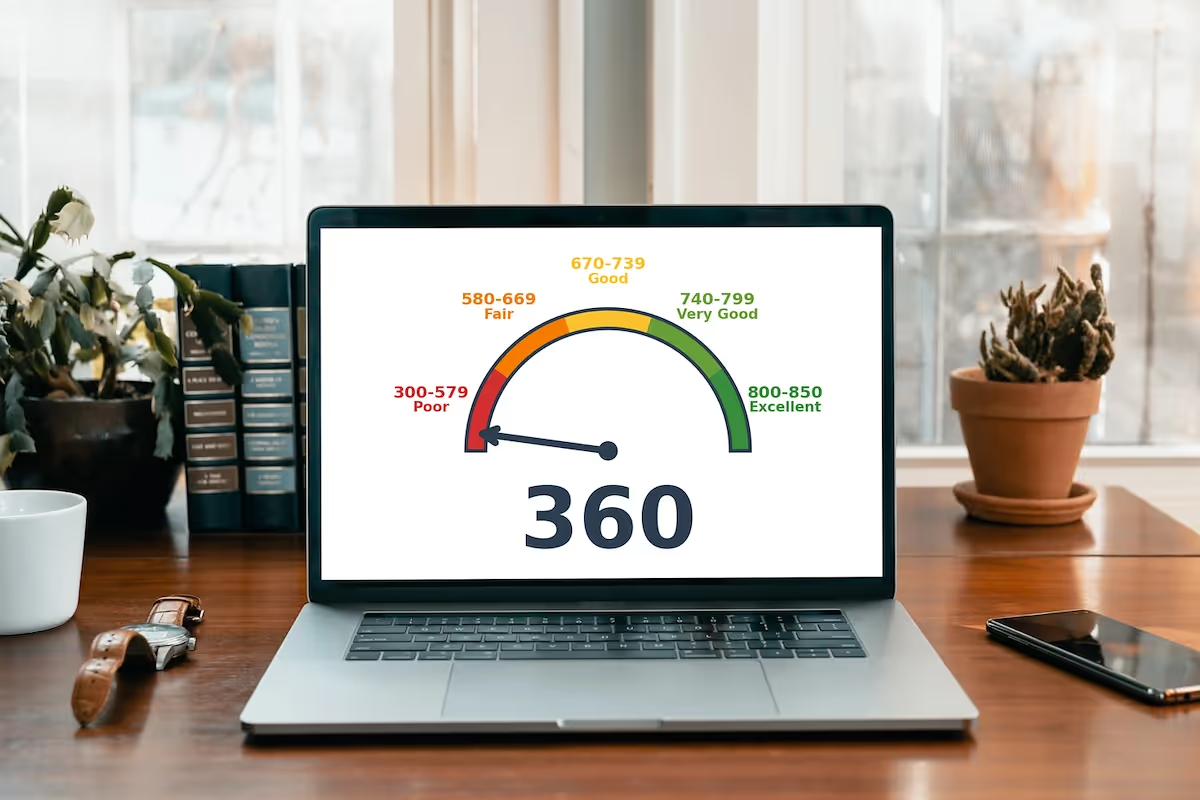
Kudos has partnered with CardRatings and Red Ventures for our coverage of credit card products. Kudos, CardRatings, and Red Ventures may receive a commission from card issuers. Kudos may receive commission from card issuers. Some of the card offers that appear on Kudos are from advertisers and may impact how and where card products appear on the site. Kudos tries to include as many card companies and offers as we are aware of, including offers from issuers that don't pay us, but we may not cover all card companies or all available card offers. You don't have to use our links, but we're grateful when you do!
360 Credit score: What You Need to Know in 2025
July 1, 2025


TL;DR
A 360 credit score offers a significant opportunity for growth and is a clear starting line for building a stronger financial profile. According to the FICO model, this score falls into the 'Poor' category, which provides a straightforward path for improving your credit standing.
What Does a 360 Credit Score Mean?
A credit score of 360 is at the lowest end of the FICO Score range, which spans from 300 to 850. This score falls squarely into the "poor" credit category. Lenders view a score this low as a significant indicator of risk, suggesting a history of financial difficulties like missed payments or high debt. It signals to creditors that you may struggle to manage financial obligations.
Financially, a 360 score creates substantial hurdles. You'll likely face rejections for new credit cards and loans, and any offers you receive will probably have very high interest rates. This can also affect renting an apartment or securing utilities without a hefty deposit. While this presents significant challenges, it's important to know that a credit score is not permanent and can be improved over time.
Who Has a 360 Credit Score?
While age isn't a direct factor in credit scoring models, there is a clear trend of scores increasing over time. Here’s a look at the average FICO scores by generation, according to 2023 data from Experian:
- Generation Z (ages 18-26): 680
- Millennials (ages 27-42): 690
- Generation X (ages 43-58): 709
- Baby Boomers (ages 59-77): 745
- Silent Generation (ages 78+): 760
Credit Cards With a 360 Credit Score
A credit score of 360 is deep in the "poor" credit range, signaling to lenders that you are a high-risk borrower. Consequently, you'll find it challenging to get approved for most traditional, unsecured credit cards. Your options will likely be limited to products specifically designed for building credit, such as secured credit cards, which require a cash deposit.
Kudos offers AI-powered tools to provide personalized credit card recommendations based on your unique financial needs and spending habits. The platform provides insights on how different cards may impact your credit score and helps evaluate if a card's annual fee is justified by your spending.
Auto Loans and a 360 Credit Score
A 360 credit score places you in the 'deep subprime' category, which significantly impacts your ability to get an auto loan. While approval is still possible, lenders view this score as high-risk, meaning you'll face the highest interest rates and strictest terms available.
- Super-prime (781-850): 5.25% for new cars and 7.13% for used cars
- Prime (661-780): 6.87% for new cars and 9.36% for used cars
- Non-prime (601-660): 9.83% for new cars and 13.92% for used cars
- Subprime (501-600): 13.18% for new cars and 18.86% for used cars
- Deep subprime (300-500): 15.77% for new cars and 21.55% for used cars, according to a 2025 rate analysis.
Mortgages at a 360 Credit Score
With a 360 credit score, qualifying for a traditional mortgage is nearly impossible. Most lenders have minimum mortgage requirements, typically a score of 620 for conventional loans. Even government-backed FHA loans, one of the most lenient options, require a score of at least 500 with a 10% down payment. Your choices are generally limited to rare specialty or subprime lenders with very strict requirements.
If you find a lender, a low score severely impacts loan terms. Expect much higher interest rates, adding thousands to your total cost. Lenders will also demand a larger down payment and may cap the loan amount, limiting your housing options. The approval process will involve intense scrutiny of your financial history.
What's in a Credit Score?
Figuring out what goes into your credit score can feel like trying to solve a complex puzzle, but it generally boils down to a handful of key elements. The most common factors include:
- Your payment history, which tracks whether you pay your bills on time, is the most significant factor.
- Credit utilization, or the amount of credit you're using compared to your total available credit, also plays a major role.
- The length of your credit history demonstrates your experience with managing credit over time.
- Having a healthy mix of different types of credit, such as credit cards and installment loans, can positively impact your score.
- Finally, recent credit inquiries, which occur when you apply for new credit, are also taken into account.
How to Improve Your 360 Credit Score
Your credit score plays a crucial role in your financial life, and improving it is entirely achievable with consistent effort and the right strategies. There are several proven methods to boost your creditworthiness, with most people seeing meaningful changes within three to six months.
- Monitor your credit reports regularly. This allows you to identify and dispute any inaccuracies or signs of identity theft that could be unfairly lowering your score. Keeping a close eye on your reports also helps you track your progress and stay motivated on your credit-building journey.
- Reduce your credit utilization ratio. Lenders look favorably on borrowers who use less than 30% of their available credit, as it shows you aren't over-reliant on debt. You can lower this ratio by paying down balances or requesting a credit limit increase on existing accounts.
- Establish automatic bill payments. Since payment history is the most significant factor in your credit score, ensuring you never miss a payment is fundamental. Setting up automatic payments is a simple way to guarantee your bills are paid on time, every time.
- Diversify your credit mix. Having a variety of credit types, such as revolving credit from cards and installment loans like a car loan, shows lenders you can manage different financial products responsibly. This diversity can have a positive long-term impact on your score.
Using a financial tool like Kudos can help you effortlessly manage your credit cards and monitor your score as you work to improve it.
Unlock your extra benefits when you become a Kudos member

Turn your online shopping into even more rewards

Join over 400,000 members simplifying their finances

Editorial Disclosure: Opinions expressed here are those of Kudos alone, not those of any bank, credit card issuer, hotel, airline, or other entity. This content has not been reviewed, approved or otherwise endorsed by any of the entities included within the post.



































.webp)



.webp)

.webp)


